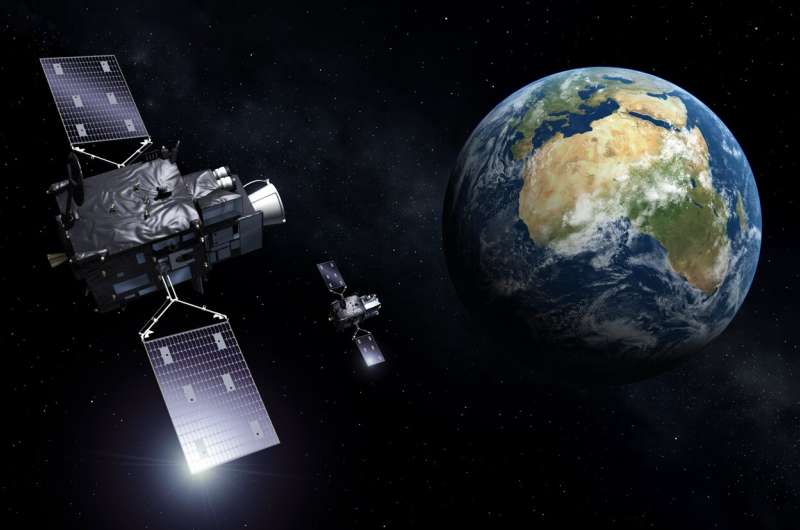Operation centers in tune for upcoming weather satellite

In just a few months' time Europe's first Meteosat Third Generation satellite will soar into the skies on an Ariane 5 rocket from French Guiana. From geostationary orbit, this new satellite, carrying two new highly sensitive instruments, will take weather forecasting to the next level. Taking a significant step towards launch, the satellite operations teams at two different centers have completed an all-important suite of tests ensuring that their procedures are fully compatible with the satellite.
These final tests, known as system validation tests, involved both Telespazio's control center in Fucino in Italy and Eumetsat's mission operations facility in Darmstadt in Germany.
Telespazio is responsible for the satellite's launch and early orbit phase, which covers the period from separation from the rocket to arrival at geostationary orbit. This phase takes around ten days and includes four burns of the satellite's liquid apogee engine and deployment of the solar arrays and communications antennas.
Eumetsat is responsible for commissioning, routine operations in orbit and the provision of satellite data to national weather services and other users.
Slated for launch at the end of November, the first Meteosat Third Generation Imager, MTG-I1, satellite carries a Flexible Combined Imager and a Lightning Imager.
To meet more than the 20-year operational life of the mission, the full MTG system comprises six satellites, four MTG-I and two sounding satellites, MTG-S.
The two MTG-I satellites will operate in tandem—one scanning the full Earth disk, including Europe and Africa, every 10 minutes, while the other will provide a local area coverage, for example covering only Europe, with a faster repeat cycle.
The single MTG-S satellite will also provide local-area coverage over selected parts of Earth, with a repeat cycle of typically five minutes.
At the moment, it's all steam ahead to get the first of these satellites, MTG-I1, into orbit.
The recent system validation tests took two weeks of double shift work at the Telespazio and Eumetsat control centers. The respective centers ran key operational procedures both for routine satellite commanding and contingency recoveries to demonstrate the compatibility of the control centers with the MTG-I1 satellite.
Over 350 different procedures were exercised during the campaign, for which review and testing against the complex MTG-I satellite simulator has been on-going since early in the year.
Ultimately, thanks to the close cooperation between all parties—including ESA, Eumetsat, Telespazio and the MTG industrial support team from Thales, OHB and Leonardo—the overall system validation test campaign has been successfully completed on time.
This means that the MTG-I1 satellite can be released for the last few tests prior to shipment to the launch site in French Guiana.
Following completion of this significant milestone, a tired but happy, Angela Birtwhistle who is responsible for coordinating the ESA operations activities reflected on a job well done, "After a long and intense preparation phase for what are the last system validation tests for MTG-I1, requiring the commitment and hard work by so many people from all organizations, it was very rewarding to achieve this key milestone.
"It is so important for the success of MTG-I1's launch and operations—and was achieved in an extremely cooperative and collaborative atmosphere."
After a short break the next major activity for the operation teams is the participation in several weeks of simulation campaigns, both for the launch and early orbit phase and routine operations. Again, routine and contingency operations will be exercised, this time against the satellite simulator.
This activity will be spiced up by the simulations officer introducing several unexpected failures with the operations support team expected to jump into action and recover the situation.
In parallel, the satellite will complete its testing in Europe, the main element of which relates to the final electromagnetic and radio frequency compatibility tests at Thales Alenia Space's facilities in Cannes, France.
This will be followed by packing and shipping, by boat, to Kourou, French Guiana, at the end of September.
Once safely in Kourou, final preparations for lift off will take around seven weeks. Launch is scheduled for late November.
The extensive and rigorous preparation work by the operations support team will then prove its worth when the separation of the satellite from the Ariane 5 rocket takes place and the MTG-I1 early orbit activities start for real.
MTG is a cooperation between ESA and Eumetsat. ESA is responsible for the definition and implementation of the MTG satellites and procurement of recurrent hardware, while Eumetsat is in charge of operating the spacecraft throughout its lifetime. The MTG satellites will replace the current Meteosat Second Generation operational system.
Provided by European Space Agency





















